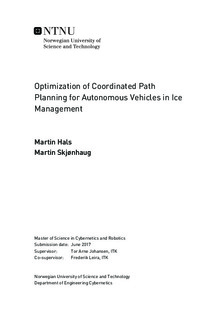| dc.description.abstract | An important part of offshore operations in arctic climates is the management of drifting sea ice due to the dangers posed on ships and offshore structures. This thesis investigates the utilization of multiple unmanned aerial vehicles for ice monitoring. A cooperative search algorithm for a team of agents to autonomously monitor and search for sea ice in a dynamic environment is presented. The algorithm reduces the continuous search problem to a sequence of online, receding horizon optimizations on a finite, dynamically updated graph whose vertices represent potential waypoints for the agents to follow. Estimates of target locations are iteratively updated by agent measurements through Bayesian recursive estimation. The main contributions of this thesis are the incorporation of a predictive step in the iterative target estimation, enabling a dynamic environment for an unknown number of targets to be accounted for. Using the estimated target topology enables the formulation of a search objective with the intention of reducing the probability of target collision with an offshore installation. The system has been implemented using MATLAB, and software in the loop testing conducted to investigate the real time performance when integrated in a fully operational system. Simulations of a variety of scenarios have been conducted, revealing a significant increase in performance by increasing the size of the search party, both with regards to search time and threat detection. The proposed search objective yields an efficient cooperative behavior for teams of multiple agents, while additionally yielding good results for a single searching agent. However, simulations show that the predictive step is sensitive to errors in the estimation of the target dynamics, which could cause problems for practical applications as the calculation of the search objective relies heavily on the expected dynamics in the search region. | |

